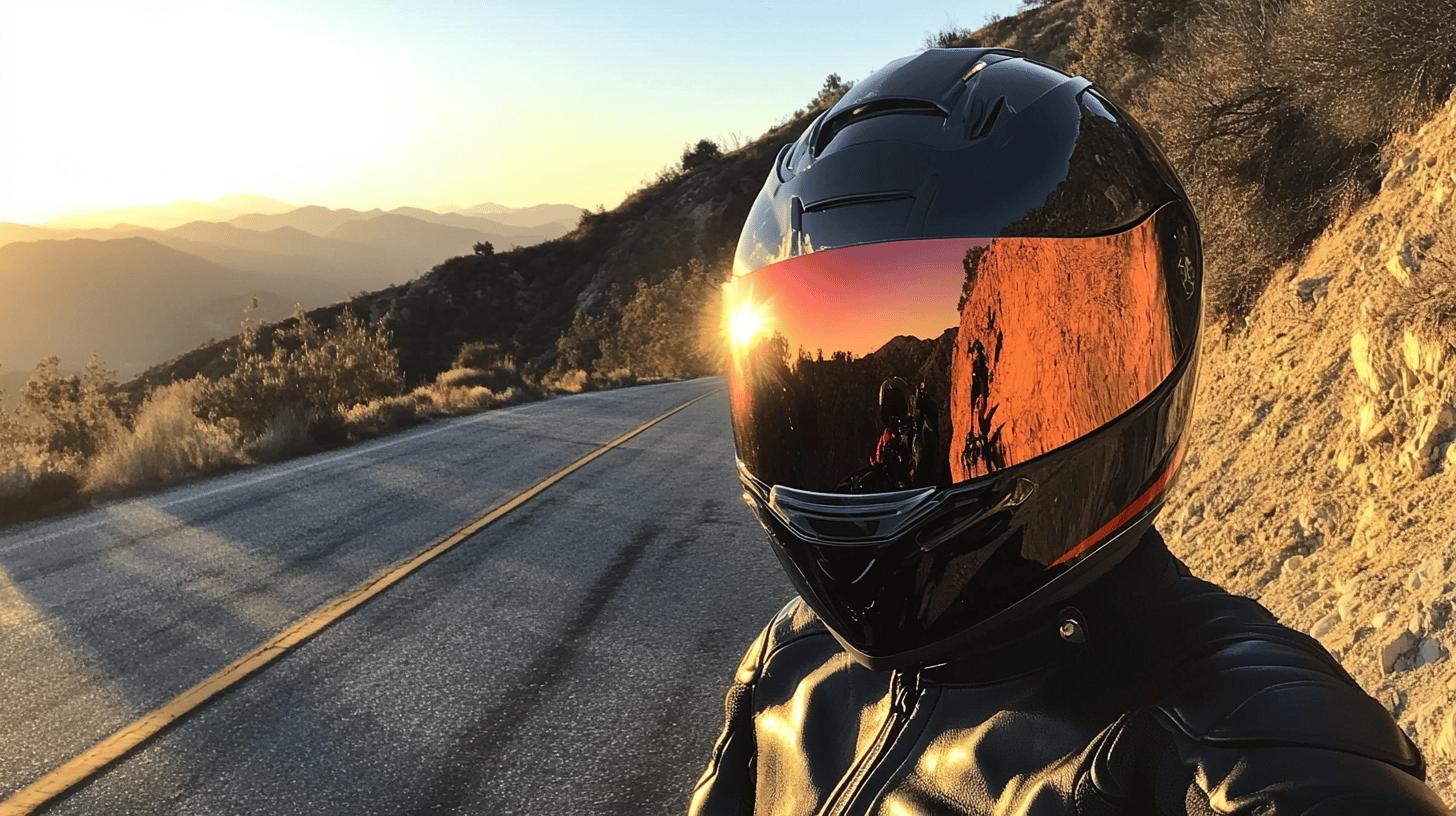Can mirrored visors truly enhance nighttime visibility for motorcyclists, or do they pose more challenges after dark? Often celebrated during the day for their sleek look and glare reduction akin to sunglasses, mirrored visors—or iridium shields—remain a hot topic when it comes to night rides.
Understanding their function is crucial to optimizing safety while riding under the stars. This article delves into mirrored visor technology, assessing their compatibility with the unique demands of night riding.
Whether you're a motorcycle enthusiast seeking stylish protection or aiming for improved safety, we'll explore whether these visors aid or hinder visibility during nocturnal journeys.
How Do Mirrored Visors Help Night Visibility?

Mirrored visors, also referred to as iridium shields, primarily serve to enhance daytime riding conditions by reducing glare and filtering out harmful UV rays. Similar to wearing sunglasses, these visors offer significant relief from the blinding sunlight, making them a popular choice for riders seeking both style and function.
These visors sport a reflective coating that not only adds an aesthetic edge to motorcycle helmets but also provides a layer of protection against the sun's intense rays. However, they aren't designed to improve visibility at night and may, in fact, impair it.
-
UV Protection: Blocks harmful ultraviolet rays to protect the eyes.
-
Glare Reduction: Minimizes sunlight glare, improving rider comfort under bright conditions.
-
Stylish Appearance: Offers a sleek, reflective look that enhances the helmet's aesthetic.
-
Daytime Suitability: Optimized for use in daylight, similar to sunglasses.
-
Visibility Maintenance: Maintains visibility by reducing eye strain during sun exposure.
Despite their limited effectiveness in low-light conditions, mirrored visors remain a favorite among motorcyclists and high-performance drivers for daytime use. Their ability to reduce glare and protect vision during bright daylight rides makes them an attractive option.
While they might reduce visibility during night rides, their popularity persists thanks to the combination of functionality and a stylish appearance. Riders often choose these visors for their utility in sunny environments, although they switch to clear alternatives for nighttime riding.
Mirrored Visors and Nighttime Visibility Challenges

Mirrored visors are not designed to assist night visibility. They are constructed primarily for reducing sun glare and UV exposure during daytime rides, which makes them less effective in low-light or nighttime conditions. The reflective coating, beneficial under bright sunlight, can hinder visibility by dimming the surrounding environment at night, making obstacles and road conditions harder to discern.
Riders face several visibility challenges at night:
-
Reduced Light Levels: Diminished ambient light makes it difficult to see road obstacles.
-
Increased Streetlight Glare: Mirrors can reflect streetlights, increasing glare and reducing clarity.
-
Limited Contrast: Differentiating between objects and the road becomes challenging in low light.
- Headlight Reflections: Oncoming traffic headlights may cause distracting reflections.
Clear visors are recommended for night riding due to their ability to maintain visibility without altering light conditions. Unlike mirrored visors, clear visors do not darken the rider's view and allow maximum light transmission, making them ideal for night or low-light riding.
This ensures that riders have an unobstructed view of the road, enhancing safety by allowing them to spot potential hazards promptly. Riders prioritizing visibility and safety during nighttime adventures often choose clear visors to ensure that their vision remains uncompromised.
Comparing Mirrored and Non-Mirrored Visors for Night Rides

Motorcyclists have a variety of visor options, including mirrored, clear, and smoked visors. Each type serves a unique purpose, particularly when considering nighttime riding conditions. Understanding the characteristics of each helps riders make informed decisions for optimal visibility and safety.
Clear Visors
Clear visors are the go-to choice for night rides due to their ability to provide unobstructed vision. They allow maximum light transmission, ensuring that riders can see clearly without any tint or reflection altering their view. This transparency is crucial for detecting road hazards and navigating through low-light environments. The absence of any tint or reflective coating means that clear visors do not impair perception, making them highly suitable for riding after dark.
Smoked Visors
Smoked visors, offering a tinted effect, are less ideal for night use. While they block out some sunlight during the day, the tint can limit the rider's ability to see clearly in low-light situations. The reduced light transmission can hinder the rider's capacity to distinguish between objects and road conditions at night. This makes smoked visors more suitable for daytime rides when the sun's brightness is a concern, rather than for night riding.
Mirrored Visors
Mirrored visors shine in bright conditions, offering significant glare reduction and UV protection. However, their reflective coating can be a disadvantage at night. The same features that make them excellent under sunlight, like glare reduction, can lead to diminished visibility in the dark.
The reflective surface can amplify glare from artificial lights, such as streetlights and headlights, making them less suitable for nighttime rides. Riders often find that switching to a clear visor at night enhances their safety by providing a clearer view of the road.
| Visor Type | Visibility at Night | Glare Reduction | Suitability for Night Rides |
|---|---|---|---|
| Clear Visors | High | None | Excellent |
| Smoked Visors | Low | Moderate | Poor |
| Mirrored Visors | Low | High | Poor |
Impact of Mirrored Visors on Rider Safety and Comfort

Choosing the right visor is crucial for rider safety, especially during nighttime rides. Mirrored visors, known for their effectiveness under bright daylight, may not provide the same level of safety in low-light conditions.
Their reflective properties, while excellent for reducing glare from the sun, can lead to reduced visibility and increased risk of accidents at night. Ensuring clear vision is paramount, as it allows riders to navigate safely and respond to road hazards promptly.
-
Vision Impairment: The reflective surface of mirrored visors can reduce visibility in low-light conditions, potentially obscuring obstacles.
-
Increased Eye Strain: Reflective glare from artificial lights can cause discomfort and fatigue, affecting focus and reaction time.
-
Glare from Headlights: Oncoming vehicle headlights can reflect off the visor, creating distractions and diminishing clarity.
- Limited Light Transmission: The mirrored finish can block ambient light, making it difficult to see details on the road.
Comfort is another essential aspect influenced by visor choice. Mirrored visors can affect comfort levels due to their tendency to darken the rider's view, which might require increased focus and concentration during night rides.
The fit of the helmet and the ventilation system also play pivotal roles in maintaining comfort. A well-fitted helmet that allows for adequate airflow helps reduce fogging and overheating, enhancing the overall riding experience. Riders should consider these factors when selecting a visor, prioritizing clear visors for night rides to ensure both safety and comfort.
Expert Opinions and Studies on Mirrored Visors

Expert opinions consistently highlight that mirrored visors, while providing significant benefits under bright daylight, are not recommended for night riding. The reflective coating that effectively reduces glare during the day can become a liability at night, as it tends to diffuse artificial light sources, leading to reduced visibility and potential safety risks. Experts emphasize the importance of choosing visors that do not compromise vision in low-light conditions to maintain rider safety.
-
Visibility Testing: Studies have shown that mirrored visors significantly reduce light transmission, with some tests indicating up to a 50% decrease in visibility compared to clear visors in nighttime environments.
-
Expert Recommendations: Safety experts recommend switching to clear visors for night rides, as they allow maximum light passage and do not create additional glare from streetlights or headlights.
-
Rider Feedback: Many riders report that mirrored visors, while stylish and effective during the day, can cause difficulty in discerning road features and obstacles at night, reinforcing the argument for using clear visors after dark.
Rider feedback often echoes expert assessments, with testimonials frequently mentioning the aesthetic appeal of mirrored visors but cautioning against their use in low-light conditions. Riders who have experienced nighttime journeys with mirrored visors often note issues such as increased glare and decreased depth perception, which can impair safe riding.
These firsthand accounts further support the consensus that while mirrored visors are advantageous in sunlight, clear visor alternatives are preferable for night riding to ensure visibility and safety.
Final Words
Assessing how do mirrored visors on motorcycle helmets help with night visibility, daytime styles offer aesthetic benefits and UV protection. However, mirrored visors pose challenges at night due to reduced visibility.
Clear visors remain preferable for optimal nighttime vision. While mirrored options suit sunny conditions, they may impair night safety and comfort. Incorporating expert advice enhances riding confidence and knowledge, ensuring riders choose the best gear for their needs. Stay informed and ride with the gear that fits your journey.
FAQ
Q: Is it illegal to wear a mirrored visor at night?
A: Wearing a mirrored visor at night is often not illegal, but many jurisdictions discourage it due to decreased visibility. Check local regulations to avoid safety issues and potential fines.
Q: What does a mirrored visor do?
A: A mirrored visor reduces glare and UV exposure, functioning like sunglasses for motorcyclists, offering style and eye protection during daylight, but can impede nighttime visibility.
Q: Can you see through mirrored visors at night?
A: Mirrored visors can reduce visibility in low-light conditions, making them less suitable for night riding compared to clear visors, which provide better visibility.
Q: Which visor is best for night driving?
A: Clear visors are best for night driving as they allow maximum light transmission, enhancing visibility and reducing glare from artificial lighting, ensuring a safer ride.
Q: What is the best visor for day and night?
A: For versatile use, opt for a clear visor at night to ensure visibility and consider a transitional visor that adjusts to sunlight intensity during the day, though it's less common.
Q: Are motorcycle helmet tinted visors illegal at night?
A: Tinted visors are not typically illegal at night, but they are not recommended due to reduced light transmission and visibility, which could present safety risks in low-light conditions.
Q: How does a clear visor benefit night rides?
A: Clear visors maximize light intake, providing unobstructed vision, crucial for night riding. They minimize glare and improve overall visibility compared to tinted or mirrored options.
Q: What are the drawbacks of using a mirrored visor at night?
A: Mirrored visors might impair night vision, increase glare from streetlights, and cause potential eye strain, making them less effective and less safe for night riding compared to clear visors.

Ryan Thompson is a 35-year-old sport bike enthusiast known for his adventurous spirit. With years of weekend rides and exploring new roads, Ryan brings fresh insights and firsthand experience to ProtectiveGearz. His energetic approach and passion for the latest gear make him a trusted source for riders seeking up-to-date advice.